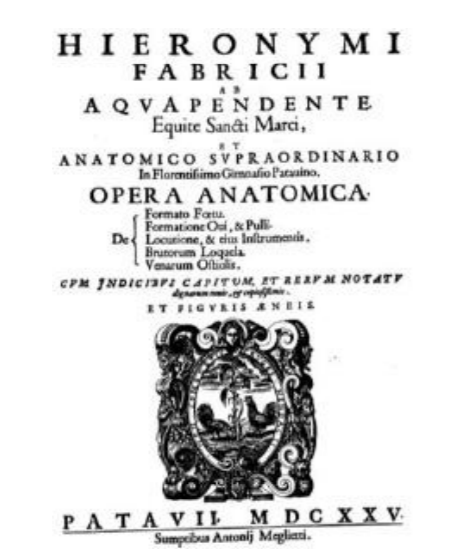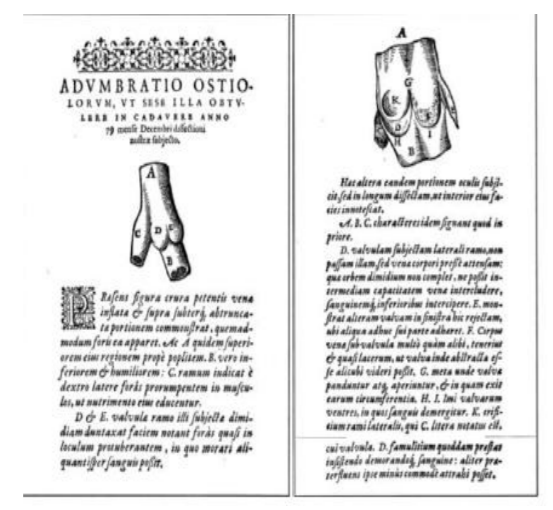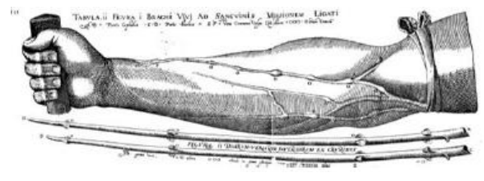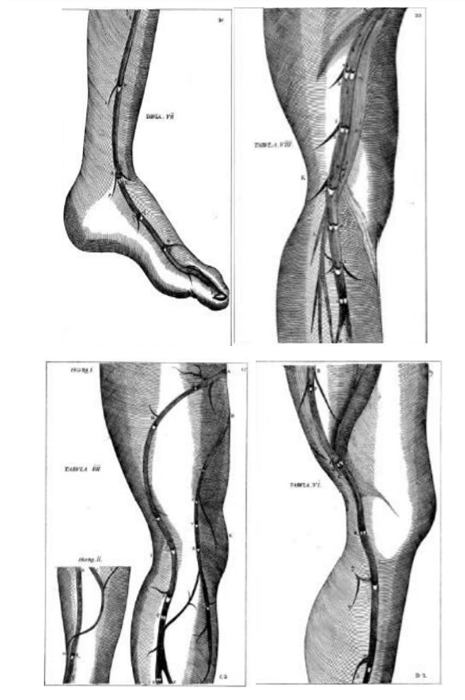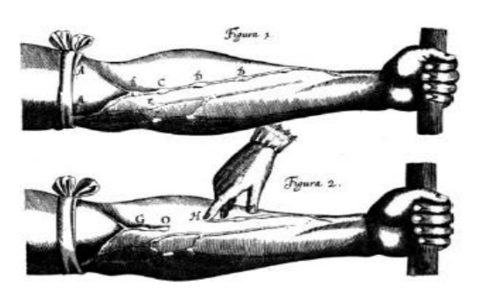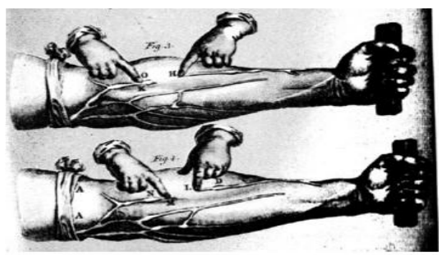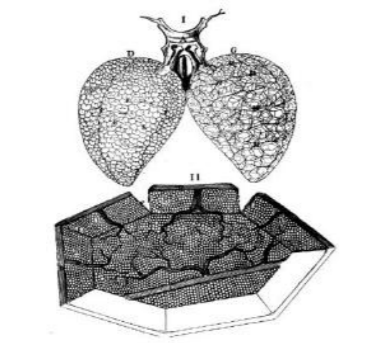Information
Journal Policies
A Brief Histoical Survey of Blood Movements (from the most ancient civilizations to Harvey and Malpighi)
S.Musitelli1*,M.A.Bertozzi2
2.Head of the operative complex Department of Andrology at the Azienda Ospedaliera Pisana (Hospital Authority of Pisa – Italy).
Copyright : © 2017 . This is an open access article distributed under the Creative Commons Attribution License, which permits unrestricted use, distribution, and reproduction in any medium, provided the original work is properly cited.
Not even the faintest allusion to blood movements may be found either in any of the most ancient and more or less ample medical texts (Egyptian papyruses, Mesopotamian tablets, Chinese and Indian medical treatises, etc.) or even in the Corpus Hippocraticum. Aristotle (384-322 B.C.) himself did not distinguish the arteries from the veins. The first anatomist who realized this fundamental difference was Praxagoras of Cos (flourished in the 2nd half of the 4th century B.C.) – Aristotle’s son in low and Herophilus’ teacher – who observed that the arteries pulse whilst the veins do not. He maintained that the veins contained blood and the arteries air. The same opinion was advocated by his disciple Herophilus (1st half of the 3rd century) and his a little younger colleague Erasistratus and was only demolished by Galen (129-c.199 A.D.), who succeeded in proving that arteries too contained blood, although the arterial one was red, whilst the venous one was rather blackish. However this exceptionally important discovery did not suggest to him even the faintest idea of blood circulation, or rather forced him to conceive a quite absurd anatomo-physiological theory, which lasted at least till the 17th century. The real problem was the following: where did ever go the breathed air if not into the arteries? This fundamental problem could be solved neither by him nor by any of all the subsequent anatomo-physiologists owing to the lack of any chemical knowledge. Even William Harvey (1578-1657), who hypothesized for the first time in the history of the Western anatomo-physiology the complete “blood circulation”1 and Marcello Malpighi (1628-1694), who finally proved it, could succeed in realizing what really happened in breathing. The problem was at last solved by the chemist Antoine Laurent Lavoisier (1742-1794), the founder of modern Chemistry.
Histoical Survey,Blood Movements,ancient civilizations,Harvey and Malpighi, Nephrology
A Brief And Necessary Introduction
We must have recourse to the term “movements” because every “circulation” is surely a “movement”, but not every “movement” is a “circulation” and the correct and final idea of “blood circulation” only started in the 17th century[2]
1 – Not even the faintest description of the blood movements can be found either in the rather alleged “medical texts” of the ancient Mesopotamia, or in those of the Ancient Egypt, or in those of the most ancient Persian, Chinese and Indian cultures. Indeed in some Assyrian and Babylonian tablets, in the ancient Egyptian 1Although the “lesser circulation” was already described by the Arab anatomist Ibn al-Nafis (1213-1288) in his Sarah Tashrih al-Qanun Ibn Sina (Commentary on Avicenna’s Canon). 2Even in spite – as we shall point out below - of the discovery and description of the valves of the veins by Giovanni Battista Canano (1515-1579), Amatus Lusitanus (1511-1568) and finally and most completely by Gerolamo Fabrizi of Acquapendente (c.1533-1619)[2].
medical papyruses, in some of the most ancient passages of the Avesta (the sacred book of ancient Persia), in the surely archaic passages of the Indian medical collection called Ayurveda (about the 5th century B.C.), in the most ancient Chinese medical treatise called Huang Ti Nei Ching su Wên (The canon of internal Medicine of the Yellow Emperor) (about 1000 B.C. if not more than 2.000 B.C.), as well as in the Indian medical treatises preserved with the names of Suçruta[3] and Caraka[4] (2nd century A.D.) – the Suçrutasamhita (Suçruta’s path) and Carakasamhita (Caraka’s path) – one can find a lot of more or less correct, more or less ample and more or less fanciful descriptions of blood vessels, this is true, but no allusion to any blood movement, let alone to the difference between arteries and veins. The first anatomist who realized this fundamental difference was Praxagoras of Cos – Aristotle’s son in low and 3Read “ç” like in “shame”. 4Read “C” kike in “church”. Herophilus’ teacher – who observed that the arteries pulse whilst the veins do not. He maintained that the veins contained blood and the arteries air. The same opinion was advocated by his disciple Herophilus and mainly by Erasistratus.
2 – Neither Hippocrates (c.469-399 B.C.), nor Aristotle himself – as said above - distinguished the arteries from the veins. By contrast Praxagoras, Herophilus and Erasistratus were aware of this fundamental difference although all of them made the great mistake of maintaining that the veins contained blood whilst the arteries contained air. Galen in his turn, succeeded in proving that the arteries too contain blood.
In his brief but most important treatise “An in arteriis sanguis contineatur”(Whether the arteries contain blood)[1] he describes how he could realize this discovery that was on the one hand fundamental, but on the other hand really catastrophic for his anatomo-physiological system. He bared and incised an artery of a living animal and could see blood spurting out. However Herophilus’ and Erasistratus’ followers5 objected against his statement as follows: as Nature is characterized by the “horror vacui” (horror for empty), you could not see the spurting out air; indeed the venal blood runs immediately to fill the voided artery and this is why you erroneously imagined that this blood was formerly contained into the incised artery. At this point Galen tied up – again “in vivo” – a tract of artery at both the distal and the proximal point so that no venal blood could reach the tied up tract This done, he incised again it between the two knots and succeeded in showing the blood spurting out! This proof was absolutely incontrovertible!!
3 – However this really astonishing anatomical procedure and the consequent no less astonishing consequence caused a disaster to his anatomo-physiological system. Indeed he could no more succeed in understanding which would ever be the task of the breathed air and was forced – as said above – to create his absurd anatomophysiology. He, as well as all the previous physicians and anatomists, were perfectly aware that:
1) the blood was necessary for living;
2) by consequence the total loss of blood was absolutely deadly; 5Who were aware of the existence of a capillary anastomotic network joining arteries and veins.
3) that blood derived from the different elaborations of the food.
According to Galen – as well as to all the previous and subsequent anatomo-physiologists till at least the 17th century – the food, first elaborated in the mouth, was “attracted” by the stomach, transformed into chyme, expelled towards the bowels, which in their turn attracted and transformed it into chyle; the chyle expelled by the bowels was attracted by the liver, which transformed it into venal blood, charged it with “natural spirit” – which bestowed the power of growth and nutrition – and expelled it, which, in its turn, was attracted by the veins and sent to and attracted by all the “parts” of a living body. The venal blood reached the left ventricle of the heart, filtered through the interventricular septum – which was thought to be pervious –, transformed into arterial blood and charged with “vital spirit”, which, in its turn, provided all the different parts with activity. The arterial blood, after having reached all the parts, went up to the cerebellum or better the so called “rete mirabile” (exquisite net) – a sort of network consisting of blood capillaries[6] – which transformed it into “animal spirit” initiating motion and sensation and reaching all the parts through the “nerves” that were considered as a third vascular system!
It is clear that, according to this absurd physiology, the whole mass of the blood, finally transformed into “spirit”, vanished – so to say – and this explained why every living body, obviously man included, was constantly forced to restore it by nourishment.
Galen’s anatomo-physiological system may be correctly summarized in the following drawing (Fig. 1) 6Which does not exist in the human brain but can be only found in the brain of the Ungulata! Ashworth Underwood, A short History of Medicine, Oxford, at the Clarendon Press, 1962, p.54)[7].
3 – And the breathed air? Which would it be its task? Simple: as said above, the food descended into the stomach, which was considered to be a sort of “cooking pot” where the food was “concocted” and transformed into chyme thanks to the “natural heat” of the heart, which acted like a cooker. In order to prevent the chyme from being burnt, the auriculae cordis acted like fans and moderated the otherwise too flaming “natural heat”!
Useless to emphasize that:
1) these are nothing but a lot of real nonsense!
2) the centrifugal movement of the blood could be only caused by the not yet acquired knowledge of the “valves” of the veins, which just prevent the blood from any centrifugal movement!
4 – At last Gerolamo Fabrizi (or Fabrici) of Acquapendente (c. 1533-1619)8 published his brief but fundamental treatise De venarum ostiolis (On the valves of the veins) [2] in 1603 (Fig. 2). We say “fundamental” because it paved the way to William Harvey9 and therefore to the final acquisition of “blood circulation”10 in spite – as we shall see be below – of his misinterpretation of the real function of the finally and perfectly described valves.
7This mistake will be corrected by Realdo Colombo (1516-1559) (who also re-discovered and described the “lesser blood circulation”) and his disciple Juan Valverde de Amusco (c.1525-c. 1587), who agreed with his master’s observations concerning both the position of the kidneys, and the “lesser blood circulation”. Concerning the position of the right kidney advocated by Galen it is worth reading Colombo’s satiric passage in book XI, 9 of his treatise [3]: “It is exceptionally interesting that Galen fretted to inquire why Nature placed the right kidney higher than the left. As a matter of fact our good Galen busted a lot – not to say in vain - about this fact because everyone could realize the entire contrary on the basis of simple experience!”
8.He held the chair of Surgery and Anatomy at the University of Padua from 1600 to 1613.
9.Who most probably reached Padua as a student just at the beginning of 1598, was one of Fabrizi’s and Galilei’s disciples and graduated in 1602.
10.Although hypothesized by Harvey and – as said above – finally proved by Malpighi.
5 – Fabrizi’s booklet is provided with 8 marvellous copper engraved plates, but he let his disciple Salomon Alberti (1540-1600) publish in 1585 [4] a first description of the valves provided with two xylographies (Fig. 3 and Fig. 4).
5 – Alberti’s plates are clearly rather rough. By contrast Fabrizi’s copper engraved ones are really marvellous and nearly perfect as everyone may realize if only takes a look of few of them. There is no doubt that most interesting is the first because – as we will see below – it was repeated and obviously modified and improved by William Harvey (Fig.5).
However in order to realize the really astonishing perfection of Fabrizi’s figures let us add the following 4 plates (Fig. 4, Fig.6, Fig. 7 and Fig. 8): No doubt Fabrizi’s descriptions and illustrations are nearly a real masterpiece. However he did not understand at all the real function of the valves and having correctly observed that they all – simple and double according to the thinner or wider vein – were just placed a little below the start11 of a lateral venous branch, he – as a still faithful “galenist” – thought that they were a sort of brakes, whose task was preventing the blood from flowing too quickly and let it enter the lateralbranches of the veins! At any rate, his final and discovery and description of the venal valves 11Obviously “start” to him, but “insertion” to us! paved the way – as said above – to William Harvey hypothesis concerning the complete blood circulation12.
6 – How could Harvey conceive the complete blood circulation? In order to solve this problem one must remember that he studied at the University of Padua and attended not only of Fabricius of Aquapendente’s lessons on Anatomy and Surgery, but also and mainly Galilei’s lessons on Mathematics and Physics and surely embraced the fundamental principles of the “Galilean scientific revolution”, which replaced the Aristotelian and Galenic “qualitative” and therefore “animistic” and “finalistic” perspective with the “quantitative” and therefore “mechanic” one [5]. By consequence his reasoning could be only the following: the average amount of the blood contained in the blood vessels is Kg. 6,5= pounds 14,444; its movements occur in about 1 minute; therefore during 24 hour they occur in 1.440 minutes. By consequence the total blood mass that moves in 1.440 minutes corresponds to Kg. 9.360 = pounds 20.800. But should the whole blood mass “vanish” transformed into spirits and be restored by the food, a man would not eat less than pounds 20.800 per day in order to avoid dying! Should the facts occur so, why a man could ever survive only eating at least pounds 4 of flesh and pounds 3 of bread? Yet he survives although eating a so little amount of food and – of course – drinking a not at all great amount either of water or of wine!
12However it is worth observing that not only Fabricius of Acquapendente paved the way for Harvey, but also Andrea Cesalpino (1519-1603), who was the first to dethrone – so to say – the liver and to put the heart at the origin of the arterial system. However it is a historical mistake to consider him as the first discoverer ob blood circulation. Indeed his statement that “fugit sanguis ad cor” (the blood runs towards the heart) does not at all allude to any “blood circulation” but simply points out what we call “a thumb in the heart”, which occurs in cases of a sudden fright, as Cesalpino himself explains: “circa metum fugit...sanguis ad cor verlut ad suum principium” (in cases of a sudden fright the blood runs towards the heart as towards its origin)! The same must be said about the alleged description of “blood circulation” by Miguel Servet (Latinized as Servetus) (1511-1553). Indeed in his Christianismi restitutio (Restoration of Christianity,) one can only find a sort of gimcrack mixture of blood, spirits and Holy Ghost that has absolutely nothing to do with science, let alone with anatomo-physiology!
7 – What does this mean? Obviously that only a little part of the total amount of the blood is spent for the nourishment of all the organs of a living body and that only this little part must be restored daily by the food. By consequence the entire blood mass is constantly the same, which does not at all “vanish” but “circulates”. Moreover the real function of the venal valves is just preventing the blood from any centrifugal movement!
8 – As said above, Harvey illustrated his revolutionary hypothesis by 4 figures, which repeat, correct and improve the first figure of Gerolamo Fabrizi of Acquapendente (Fig. 9):
Figure 1 and Fabrizi’s first figure are the same, whilst the second shows the real function of the valves: should the finger be pressed along a vein, in a direction away from the heart, from one node (corresponding to a valve) to the next (for instance from O to H) the tract OH will be emptied of blood and will remain empty because the valve O prevents it from flowing away from the heart (the subsequent two figures confirm what the second clearly shows: Fig. 10).
9 – Harvey’s hypothesis was confirmed by Marcello Malpighi by observing, describing and illustrating the structure of a thinnest slide of a dried lung of a frog. He informed his master Giovanni Alfonso Borelli (1608-1679) sending him two letters [7]13 (Fig.11).
10 – However, in spite of Harvey’s absolutely correct hypothesis and Malpighi’s proof of blood circulation, none of them could realize how and why the venal blood transformed into arterial blood during the lesser circulation heart-lungs-heart. They could not find even the faintest solution to this otherwise clearest event owing to their lack of any knowledge of modern Chemistry only founded – as said above – by Antoine Laurent Lavoisier (1742-1794), who made a really revolutionary discovery: he succeeded in proving that respiration is nothing else than a particular sort of “combustion”: the arterial blood – charged with CO2 during the tract heart-periphery-heart – changed into venal blood, which in its turn during the tract heart-lungs-heart discharged CO2 and charged H2 becoming again arterial blood. This fundamental discovery started the modern pneumatology and haematology.
References
- Galen, An in arteriis sanguis contineatur (Whether blood is contained into the arteries), in Claudii Galeni Opera Omnia Editionem curavit D. Carolus Gottlob KÜHN, Lipsiae, in Officina Libraria Car. Cnoblochii, 1820 ff., IV, 703 ff.
- Gerolamo Fabrizi da Acquapendente- Delle valvole delle vene, edited by Felice Grondona in Studi e testi di Storia della Medicina (Studies and texts on the History of Medicine), 10 – Università degli Studi, Milan,1966.
- Realdi Columbi Cremonensis...De re anatomica libri XV (XV books on anatomy by Realdo Colombo of Cremona), ex typographia Nicolai Bevilaque (from Nicolas Bevilcqua’s press), Venice, 1559.
- De valvulis membraneis quorundam vasorum, etc.(On some membranous valves of certain vessels), in Tres orationes, etc., Authore Salomone Alberto (Salomon Alberti’s three discourses, etc.), Nürnberg, 1585.
- S. Musitelli, The Galilean revolution in Europe- The cradle of Urology, History Office of the European Association of Urology, Arnhem, 2010, p. 40 ff.
- W. Harvey, De motu cordis et sanguinis in animalibus (On the movement of the heart and the blood in animals), Wilhelm Fitzer, Frankfurt A.M., 1628.
- Marcello Malpighi, De pulmonibus, edited by Luigi Belloni in Per la fondazione della Società Italiana di Istochimica, etc. (On the occasion of the foundation of the Italian society of Histochemistry, etc.), Messina-Palermo, October 1958.






